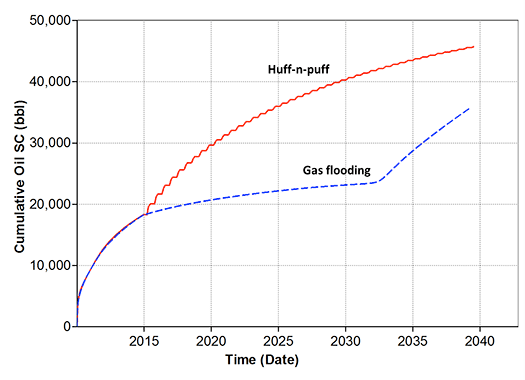Dr. James Sheng Awarded $1.2M DOE Grant to Maximize Liquid Oil Production from Shale Oil and Gas Condensate Reservoirs by Cyclic Gas Injection

By Amanda Miller
The United States possesses abundant shale resources that have the potential to produce significant amounts of both gas and oil. While shale gas can contribute greatly to domestic energy resources, oil production is more lucrative because of its ability to be collected and more easily transported. However, even after completing the hydraulic fracturing process in shale reservoirs, only about five to six percent of the oil is actually recovered. The question then remains, how can the remaining 95 percent of oil contained within shale rocks following the "fracking" process be claimed? Dr. James Sheng, associate professor petroleum engineering at Texas Tech, and Dr. Marshall Watson, Roy Butler Chair and associate professor of petroleum engineering, believe the answers are there. Backed by a $1.2M Department of Energy grant, the Apache Corporation, the Los Alamos National Laboratory, and the Texas Tech Bob L. Herd Department of Petroleum Engineering, the Sheng research group aims to enhance oil recovery in shale reservoirs through gas injection, also known as "Huff n Puff."
In the past, it was common to inject gas or water through an injection well at some distance away from a production well. The high pressure near the injector essentially pushes oil towards the production well. However, this method is difficult to implement in a shale reservoir because a high injection pressure decreases to a very low value near the injector. This is caused because the shale reservoir's ultra-low flow capacity (impermeability) complicates pushing oil toward the producer, a few hundred feet away. In contrast, the "Huff n Puff" method utilizes one well as both the injection well and the production well. Gas is injected through the well during the "huff" period, and after some gas soaking time, the "energized" (or pressurized) oil is collected through the same well during the "puff" period. Oil also becomes less viscous and more "swollen" by gas, making it less dense so that it may then be more easily extracted. This process is repeated, and each successive attempt permits the gas to penetrate further into the shale reservoir until the remaining oil that could not be originally recovered is removed at the well site. This repetitive process could potentially become a method to improve oil recovery over the conventional depletion method in industry.
Recognizing this pressing demand in industry, Sheng explored many different techniques and options before concluding that "Huff n Puff" gas injection may be the most promising technique and holds the most potential for future adoption in industry. Not only is this method more feasible than flooding approaches, it provides quick return on oil well investments. Because re-injected gas radiates further from the injection location, this technology allows the collection of consecutive portions of oil. The reservoir can also be produced by multiple wells simultaneously, each operating independently as both injection and production wells, and providing a much quicker return on investment than previous technologies.
The proposed cyclic gas injection technology uses natural gas, which is readily available in liquid-rich reservoirs. It makes more efficient use of natural gas resources to produce more in-demand oil. From the aspects of broad and long-term impact, the proposed technology can sequester carbon dioxide. It does not use water, so it does not exacerbate water scarcity. It also does not require drilling more wells. Because the produced or associated gas can be re-injected into the reservoir, oil production can continue without the wasteful and environmentally-harmful process of "flaring" or burning gas. Therefore, this project will provide an environmentally prudent technology to produce oil from the large shale resources, which currently have a very low recovery rate. The developed technology from this project will significantly increase oil production in the nation, and help to ensure an adequate oil supply.
The objectives of the research include to experimentally determine whether or not "Huff n Puff" practices are better than their conventional counterparts, to identify the most effective injection scheme for this method, and to discover economic impacts of this technology in industry. The plan is to first simulate this new approach in a laboratory environment and then conduct in-depth field-testing, with Apache support. A post-doctoral researcher, doctoral students, and highly qualified undergraduate students will participate in this three-year project. Access to superior equipment at Los Alamos National Laboratory will also enhance Texas Tech's quality of education and ability to facilitate large-scale research like this in the future.

Grant Title:
Maximize Liquid Oil Production from Shale Oil and Gas Condensate Reservoirs by Cyclic Gas Injection
Edward E. Whitacre Jr. College of Engineering
-
Address
100 Engineering Center Box 43103 Lubbock, Texas 79409-3103 -
Phone
806.742.3451 -
Email
webmaster.coe@ttu.edu
